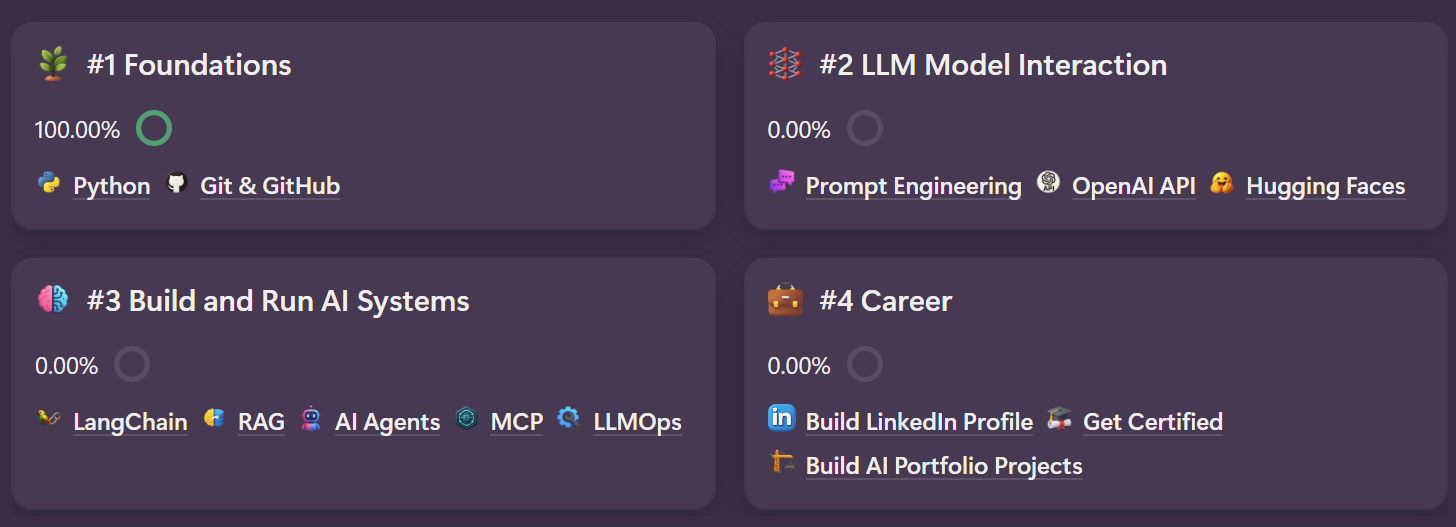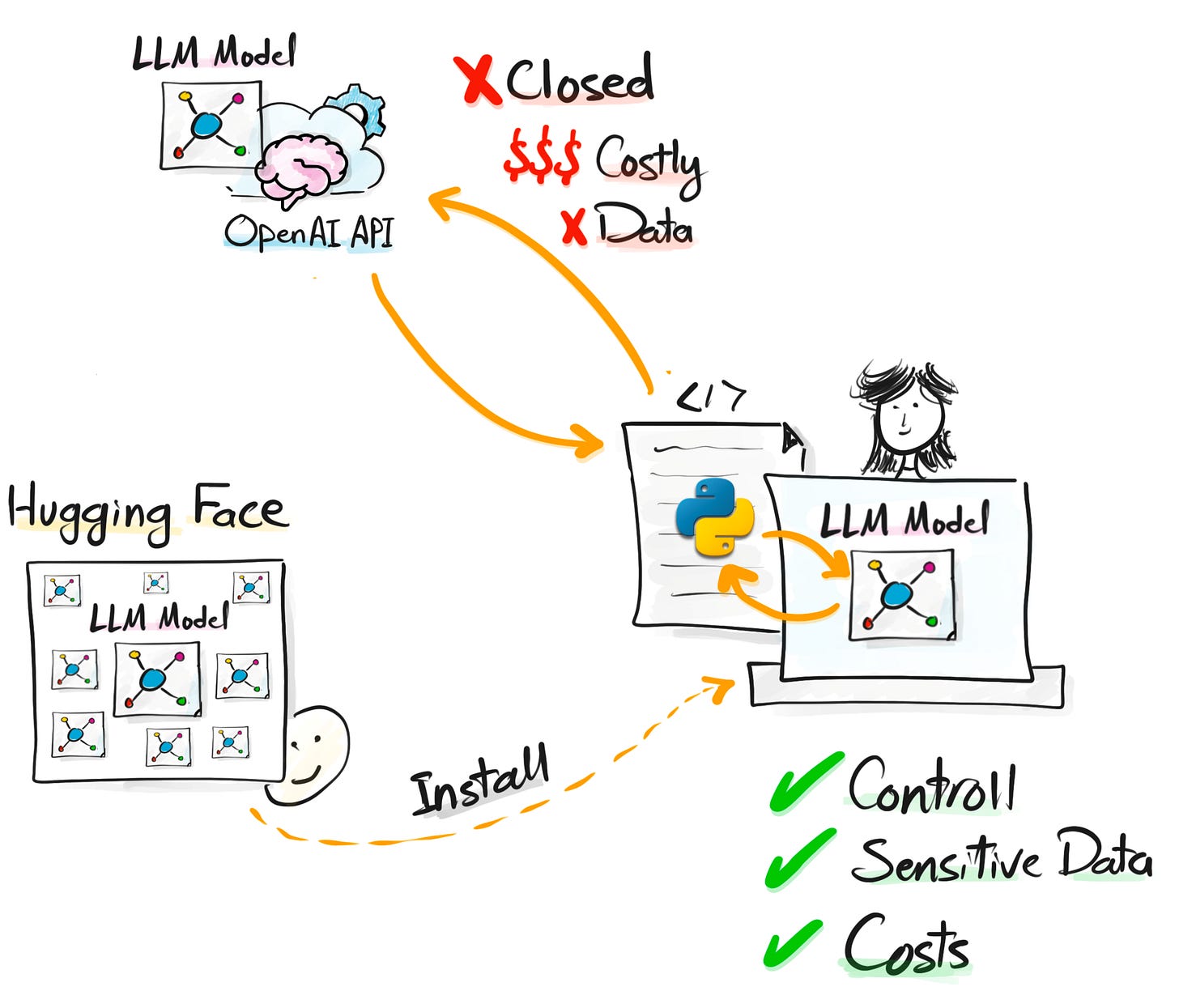AI Engineering Roadmap For 2026
The skills you actually need to get hired. A practical, industry backed path to becoming a real AI engineer
Hey friends - Happy Tuesday!
There is a lot of noise around AI engineering, and most of it makes the journey look harder than it really is. And to be honest, most of the “AI Engineering” roadmaps you see online are actually Data Science roadmaps with a different title.
That is why I decided to build a proper roadmap myself. Over the last years, I’ve worked on multiple AI projects in industry, and I’ve seen exactly what companies expect from a real AI engineer.
The [Full Notion Roadmap] is simply a reflection of that. Just the practical steps that match the work.
Let’s go.
What AI engineering really means
AI engineering is a builder role.
You are not training models, designing networks, or doing research. Companies already have strong models available. Your job is to take these models and turn them into something useful inside the business.
That means connecting the model to company data, integrating it with internal tools and workflows, and giving people a clean way to use it. And while doing that, you make sure the system is safe, fast, and reliable.
This is why AI engineering feels closer to data engineering and backend work than to data science. Once you see it this way, the whole roadmap becomes clear.
AI Engineering Roadmap
Now that you know what the role actually looks like, here is the path I recommend. These are the phases that will take you from the basics to building real AI systems, and I’ve split everything into four clear phases. You can open the full Notion roadmap here: [LINK]
🌱 #1 Foundations
Learn Python and Git GitHub so you can build a solid technical base and write code with confidence.🧠 #2 LLM Model Interaction
Master prompting and APIs like OpenAI and Hugging Face so you can talk to models, control them, and integrate them into your own code.🧩 #3 Build and Run AI Systems
Learn LangChain, RAG, AI agents, MCP, and basic LLMOps so you can build complete AI systems that understand your data and run reliably.💼 #4 Career
Build strong portfolio projects, upgrade your LinkedIn profile, and earn certifications so you can stand out in today’s competitive market.
let’s deep dive into each phase.
#1 The Foundations (Python and Git)
Before you build anything with AI, you need a simple foundation. And that foundation is Python.
Almost every tool, model, and workflow in AI runs on Python. You do not need to master every corner of the language, but you should feel comfortable with the essentials. Lists and dictionaries, loops, functions, working with JSON, and making API requests. These few things show up in almost every AI project.
Once you start writing code, you also need a place to store it and manage it. That is where Git and GitHub come in. Create a repo, push your work, write clear commit messages, and use branches when you try new ideas. It keeps your work organized and makes you look professional when you apply for jobs.
With Python and Git in place, you have everything you need to start building real AI projects.
#2 LLM Model Interaction
Once you have the basics in place, the next step is learning how to work directly with AI models. This is where AI engineering really begins, because now you move from writing normal code to controlling intelligent systems.
Prompt Engineering
Prompt engineering is the part most people misunderstand. It is not typing a short phrase into a chat window and hoping for a good answer.
It is clear communication.
It is giving context, describing the task, setting the role, and showing examples of what you want.
Good prompts make the model stable and predictable. Weak prompts make the model chaotic.
This skill becomes the backbone of every AI workflow you will build later.
OpenAI API
After you understand prompts, the next step is learning how to call models through an API [LINK].
This is when you stop “using AI” and start “building with AI”.
Calling a model from Python lets you integrate AI into your own tools, scripts, and applications.
You send a structured request, receive a response, and use that output anywhere you want.
It is a small technical step, but it opens the door to real engineering work.
Hugging Face
Once you try the OpenAI API, explore the world of open source models.
Hugging Face is the main hub for that [LINK]
Open source models give you more control, can run locally, and are often preferred by companies that care about privacy or cost.
You do not need to fine tune huge models. Just learn how to load smaller models, run inference, and use pipelines.
Knowing both open and closed models makes you far more flexible as an engineer.
Once you learn these three skills, you can talk to models, integrate them into real code, and choose the right model for each use case.
This is the core of LLM interaction and the real start of AI engineering.
#3 Build and Run AI Systems
This is the phase where you move from playing with models to actually building AI systems.
You are no longer just calling an API. You are connecting pieces, adding logic, and creating something that can run inside a company.
This is where AI engineering truly becomes engineering.
LangChain
Once you can talk to models, you need a way to organize the workflow around them.
LangChain is the framework that helps you connect models, tools, memory, prompts, and multi step logic into one pipeline [LINK]
Even a small workflow teaches you a lot.
You learn how to structure the steps, how the model moves from one action to the next, and how to build the logic that sits around the model.
RAG
RAG solves one simple problem. Models know a lot about the general world, but they do not know anything about your company data. RAG gives the model the information it needs at the moment it needs it.
Here is how it works.
You start with your internal sources. PDFs, documents, product sheets, API responses, database tables. You split them into smaller chunks because models cannot read huge files in one go.
Each chunk is turned into an embedding, which is just a list of numbers that represent the meaning of the text. These embeddings get stored in a vector database, which can search by meaning instead of keywords.
When a user asks a question, the system creates an embedding of that question and searches for the closest matching chunks in the vector database. That is semantic search.
The retrieved chunks are then added to the prompt, and the model uses them to answer the question based on real company information, not general knowledge. This keeps the answers accurate and grounded.
In simple terms, RAG gives your model a memory made from your own data. And that is why almost every AI assistant and internal AI tool today uses this pattern.
AI Agents
A chatbot gives you text.
An agent gives you actions.
Agents can call APIs, query databases, update records, trigger workflows, read emails, and much more.
This is what companies want today: AI that actually does work.
Learning how to set up tools and give the agent the ability to take actions is a key part of becoming an AI engineer.
MCP
Connecting AI agents directly to real systems is risky. They could access the wrong data or run actions you did not intend. MCP fixes this by adding a safe, standard layer between the agent and your tools.
Each system you want to connect runs through an MCP server. The agent talks to these servers using the MCP protocol, and the servers decide what the agent is allowed to do. This gives you permission control, clear logging, and a simple way to plug in new tools without rebuilding everything.
Because of this, MCP is becoming a key part of modern AI systems. It keeps your environment protected while still letting agents perform real work.
LLMOps
Once your system works, you are only halfway done. You still need to keep it healthy. That is what LLMOps is about. It covers the day to day operational work that keeps your AI system stable. Monitoring, logging, testing your RAG pipeline, tracking prompts, setting up CI CD, and keeping an eye on costs.
When these parts are in place, your system runs reliably. When they are missing, things start breaking quietly behind the scenes.
#4 Career
Companies look at your GitHub before they invite you to interviews. A strong portfolio shows you can actually build AI systems, not just talk about them.
These three projects cover the main responsibilities of an AI engineer: using company data with RAG, turning questions into SQL, and building agents that take real actions. Build one or two of them well, document everything clearly, and your portfolio is ready.
Project 1 · Talk to Documents
A simple RAG assistant where users upload PDFs and ask questions. The system retrieves the right text, answers clearly, and shows citations.
Project 2 · Talk to Data
An AI tool that turns natural language into SQL, runs the query, and returns a table or chart with a short summary.
Project 3 · AI Email Agent
An automation agent that reads incoming emails, follows clear rules, and drafts or sends replies through the Gmail API.
So my Friends…
AI engineering is not about training models or doing research. It is about building systems that use existing models to solve real problems.
Once you see it this way, the whole path becomes much easier.
You start with the foundations by learning Python and Git. Then you learn how to talk to models through prompting, the OpenAI API, and Hugging Face. After that, you move into the real engineering work with LangChain, RAG, agents, MCP, and the basic operations that keep everything running. And finally, you pull it all together with a portfolio that shows you can build something end to end.
If you follow these four phases and build at least one solid project, you will have the skills companies are searching for right now. This is the path I recommend, and it is the same one I use when guiding people personally.
Thanks for reading. ❤️
Baraa
Also, here are 3 complete roadmap videos if you’re figuring out where to start:
📌 Data Engineering Roadmap
📌 Data Science Roadmap
📌 Data Analyst Roadmap
Hey friends —
I’m Baraa. I’m a Data Engineer with over 17 years of experience, Ex-Mercedes Benz, and the creator of Data With Baraa on YouTube. I visually explain complex data concepts and build courses with real-world projects and practical lessons that help people grow their careers.













Hi Baara,
As a data engineer do you think we should be moving into this or is data engineering here to stay in your view?
Hey Baraa, thanks for sharing this!
One question: Are you going to cover Python libraries like Pandas, Numpy and Matplotlib in youtube?